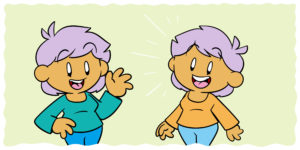Chase scenes: you know a good one when you see it, but they can still be difficult to dissect. Why does one chase scene leave you sweating, your heart in your mouth, while another fails to evoke even a slightly widened eye? Well, excitement is a difficult thing to get right. Just ask anyone who’s struggled over a fight scene.
The humble chase takes many different forms; maybe yours is a high-speed car chase like in Moonraker; maybe it’s a stop-start, cat-and-mouse game like in Richard Stark’s Slayground; or maybe it’s a story-long struggle like in Mad Max: Fury Road. Either way, there are some hard-and-fast guidelines you’ll want to keep in mind for when things get dramatic. Let’s take a look.
Plan your chase
Sorry to start with the boring stuff, but if you’re going to write a tight chase scene that maintains momentum and feels consistently exciting, you’re going to need to plan. This is also important for crafting a realistic chase – after all, if your gritty action hero hits impossible speeds in his Peugeot, turns down a non-existent road in London, or takes a mathematically impossible jump or turn, you’d better believe someone somewhere is going to snort, roll their eyes, and toss your book aside.
A good plan also ensures that your chase’s stakes are sufficiently high and that you’re layering in suspense and questions from the get-go. You should be asking yourself why this chase matters, what the stakes are, and how it’ll resolve itself – will the cop catch the villain in a straightforward and, frankly, rather boring manner, or will they guess their route, stop on an overpass, and prepare for an almost impossible shot, as in Line of Duty? Keeping your reader on their toes and shifting the dynamics of your chase on the fly can make for some seriously engaging reading.
If yours is a breakneck, high-drama chase as opposed to an extended, plot-wide stalking – a car chase maybe, or a cowboy riding down a fugitive across the badlands – make sure to plan your route. Nothing stymies pace and momentum like a writer who doesn’t know where his characters are going; trust me, your reader will know. For the car chase in Moonraker, Ian Fleming sent his stepson out to drive the route and ensure realism. Nowadays, Google can give you that kind of information in seconds, so there’s no excuse for not doing your homework.
Your reader needs to know how each event in your chase affects its outcome.Click To TweetThe events in your chase – the ramming, the stalling, the tripping, the shortcuts – only matter because they alter the distance between the characters. They inform the likelihood of the chase’s outcome, and that makes them dramatic. The reader needs to understand what every event means, and that’s much, much easier to do naturally when you plan ahead. Slayground gives its protagonist a lot of time to explore its setting and even set up traps for when the chase begins. Everything that happens thereafter gains relevance – every route that’s cut off, every turn that’s taken, means something to the reader. That’s the payoff of planning.
Use your limits
Few things sap the life out of dramatic scenes like too much information, and there are few scenes as dramatic as chase scenes. As such, it’s important to draw some hard limits around your work. This extends to several different aspects of writing: description, information, detail, dialogue, choreography… all need to be curtailed if your chase scene’s essential drama is to shine through.
Try to leave as much to your reader’s imagination as possible. This means keeping the action simple and realistic enough to follow (after all, outlandish or improbable actions tend to necessitate detail) and keeping your narration focused only on what’s happening with the chase – no motorbike riders taking time out to enjoy the stunning vista beyond the dirt trail please!
A good chase scene (like any action scene) relies on brief, punchy sentences that are light on description and heavy on verbs. Similarly, dialogue should be kept to a minimum, with only the necessary exclamations taking priority – after all, your detective is unlikely to launch into a detailed monologue while vaulting a chain-link fence in hot pursuit of her suspect.
Look at how Ian Rankin writes this thrilling car chase in the Rebus novel, Tooth and Nail:
‘Hold tight,’ Rebus said, baring his teeth. The horn was a banshee wail as they pushed past the waiting traffic and flew across the intersection, traffic from left and right braking hard. One car dented the back of another. A motorcycle slewed on the greasy road. But they were across. The BMW was still in sight, less than half a dozen cars ahead now, yet still apparently unaware of the pursuing demon.
– Ian Rankin, Tooth and Nail
Note the single imperative uttered by Rebus, the sensory information of the horn blaring, the short sentences, the heavy focus on actions and verbs instead of detailed description – all these contribute to an effective and exciting chase scene.
Another thing Rankin does effectively here is keep track of what’s going on – it’s easy to get tied up in the intricacies of your own chase, especially when you’ve got overly complex choreographies unfolding or simply too much going on. Here, things are kept simple: Rebus flies across the busy intersection, almost causing a pile-up, and then we’re straight back to the chase. Rankin even checks in to let us know where the pursued BMW is and how it’s doing. It’s easy to follow despite the chaos of the braking traffic.
Details get in the way of action – cut everything you don’t need.Click To TweetAs you’ve probably gathered, details need to be kept to a minimum. Make sure the few you use are vital and are performing as they should be. In Rankin’s prose, the single adjective, ‘greasy’, is suitably sensory and evocative, conjuring images of tires skidding on wet asphalt. Otherwise, the description is remarkably vague: the car hits ‘the back’ of another, and the cars are just cars – we get nothing about the colors, the brands (beyond the brand of the pursued car, which stands in for the noun ‘car’), or the environment they occupy.
Pace the pursuit
As is appropriate, I’ll keep this one short. The suddenness and immediacy of your chase should be reflected in your scene’s pacing and in the structure of your sentences – after all, in a chase, even a second can make all the difference.
See how Rankin achieves this in the above example: “One car dented the back of another. A motorcycle slewed on the greasy road. But they were across.” This structure emphasizes the suddenness of the occurrences described and, by locating the results at the very end of the triplet, keeps readers on their toes. Ideal.
Keep perspective in sight
I’ve talked already about limiting yourself when writing a chase scene, and this is also true of perspectives. In action-heavy scenes, objective and omniscient third-person narration can harm your ability to pump in a sense of excitement. Such narration is detached from the action, and your aim should be to throw your reader in at the deep end.
This means you’re better off narrating through a character. Now, this doesn’t necessarily mean you have to use first-person narration; limited third-person narration can work wonders too. By this, I mean you limit what you’re narrating to things the pursuing/pursued character can themselves sense. Consider this scene from Justin Cronin’s The Passage:
She heard more popping, and with the pops came flashes of light, severing the darkness like a blade. At those instants she could see everything around her: her house and the fields and the men moving through them, men who sounded like soldiers but weren’t dressed like soldiers, who swept the ground before them with the barrels of their rifles.
– Justin Cronin, The Passage
Here, the third-person narration is limited to what the pursued character can see and hear. Information is withheld from the reader just as it is withheld from Lacey – both she and the reader are given only the sound of popping, the flashes of light, and then suddenly the full picture: armed men sweeping the trees. It’s effective because the reader is there with her, panting in the woods, trying to piece together information about who these armed pursuers are.
Perspective can be similarly reflected in how you structure your sentences. A third-person narrative voice can seem more personal if, for example, short, punchy, sensory sentences find themselves breaking up longer, more descriptive sentences. In this way, the shorter sentences mimic the immediate action of the character’s experience.
Action, verbs, and the five senses
Last but not least, it’s worth reiterating the importance of action, verbs, and the five senses. If your reader is going to feel like they are part of the action, they’re going to need to be able to tap into their sensory memories, and the best way to encourage this is to involve a whole lot of sensory information.
Sense writing makes chase scenes come alive.Click To TweetThis means the wind whipping the face of the cowboy, the blinding sun silhouetting his target, the tinny taste of adrenaline, the ringing in the ears following a thunderous gunshot, the smell of gunsmoke. Of course, don’t go overboard – if you find that you’ve dedicated more space to sensory description than you have to verbs and actions, you’ve gone too far. Back up!
After all, a chase is nothing without action. If you’re going to keep your pace suitably breakneck, you need actions and verbs coming thick and fast. These need to be the backbone of the pursuit.
Cutting to the chase
Writing a chase is easier these days than it was back before contemporary media saturation – you can rely on your readership having consumed dozens of movies and TV shows full of all manner of chases, from cars to boats to horses. They’re psychologically primed to pick up on your cues and to create their own Hollywood-honed visualizations of the chases you’re describing.
That said, you can help them along their way using the methods I’ve outlined here. Remember: keep it short, punchy, and light on detail, and focus on verbs and actions. Have a plan, go at it from the character’s point of view, and evoke the five senses. Simple.
Did I miss any tips for writing a great chase? What are your favorite literary chases? Let me know in the comments. Or, for more great advice, check out 5 Popular Misconceptions About Story Pacing and The 5 Immutable Laws Of Writing A Good Action Scene.






5 thoughts on “Want The Secrets Of A Great Chase Scene?”
Thank you for the insightful article. I love chase scenes, they can be so adrenaline inducing. I want to capture this for my own stories as well.
Hi Francis,
Thanks for the comment, and I’m glad you enjoyed the article! Best of luck with your own chase scenes.
Fred
Thanks for the short course on race/action scenes. Even the good ones like Justin Cronin can raise hackles. When you are being shot at, you see the flash first and then hear the crack of the shot, not the other way around. Light travels faster than sound. The greater the distance, the greater the time between the flash and the crack. That sniper that barely missed me on my first weekend in Vietnam was in a village outside the perimeter while I was on guard duty. I saw the flash, and instantly thought cigarette lighter, then I heard the crack followed almost immediately by the fluttering whir of the round tumbling past my left ear and then a startling sharp “spang” when it hit something metallic behind me. Time doesn’t slow down in moments like that. Your perception speeds up. Your senses tell you which element of the sniper shot came to you first. Fifty years later, I still re-experience that one moment more than most others. I believe it’s because it was a lone sniper with me at the other end of his very personal and deadly intent. (I should add that the entire perimeter came alive with arc lights, flares, and the barking of dogs. And since there were no more shots fired in our direction that night, we weren’t permitted to fire into the village.
(Forgive the length of this. I think this is my best written description of this action moment. And it’s interesting that every time I think on that moment, I unintentionally tilt my head to the right and lean to the right. Trying to increase my distance from that bullet.)
YMMV
Thanks, Fred and thanks, Ed for your excellent description, and out-of-the-box “chase” scene that is instructive for us writers.
Very helpful. Thanks! Greg